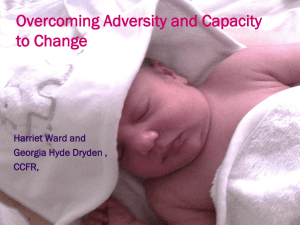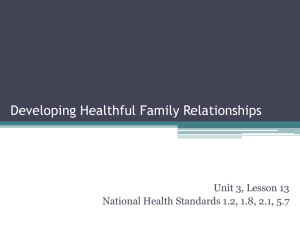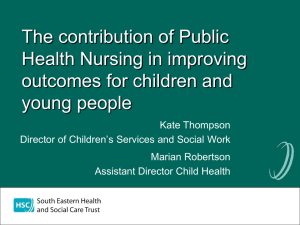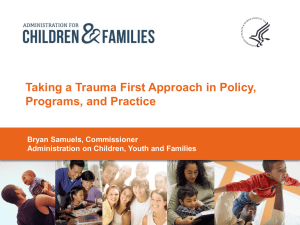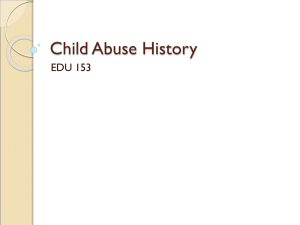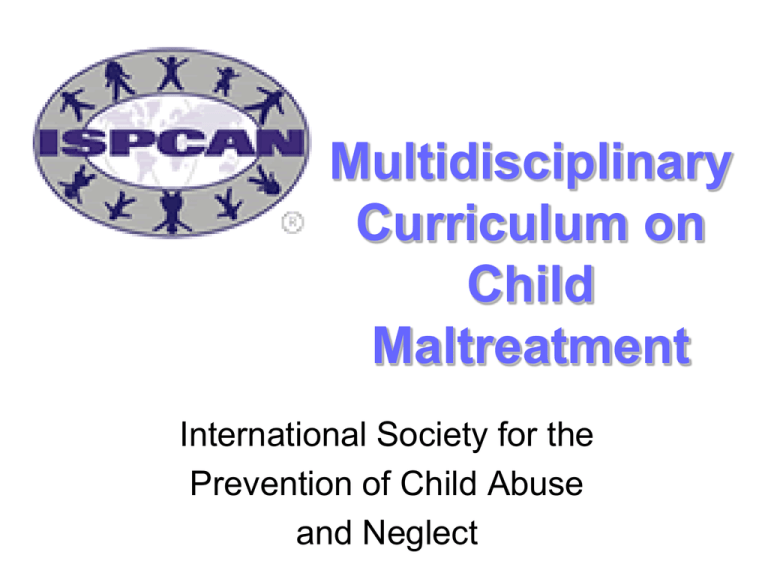
Multidisciplinary
Curriculum on
Child
Maltreatment
International Society for the
Prevention of Child Abuse
and Neglect
Multidisciplinary Curriculum
Committee Members
Robert Morris (Chair)
Jingqi Chen
Hiroaki Ishikawa (Co-Chair)
Anne Hollows
Wambui Njuguna
Elena Volkova
Clemencia Ramirez
Editors:
Howard Dubowitz
Wendy G. Lane
What is Child Maltreatment?
Child Maltreatment
Definition
All forms of physical and/or emotional
ill treatment, sexual abuse, neglect or
negligent treatment, or commercial or
other exploitation, resulting in actual or
potential harm to a child’s health,
survival, development or dignity in the
context of a relationship of
responsibility, trust or power.
(World Health Organization 1999)
Why is child maltreatment
a concern?
Incidence of Child Maltreatment
50
43
40
40
Rate per 1000
31
30
20
11
10
0
Physical
Abuse
NCANDS
Sexual
Abuse
NIS-4 Harm
Neglect
NIS-4 Endanger
Total
Self report
Rate per 1000
Incidence of Child Maltreatment
250
225
200
175
150
125
100
75
50
25
0
250
150
NCANDS
6.6
2.3
Physical Abuse
Sexual Abuse
NIS-4 Harm
NIS-4 Endanger
Canada
WHO Estimates
Known
cases of
child abuse
and neglect
are just the
tip of the
iceberg.
Rates of Harsh Physical Punishment
60
50
Chile
40
Egypt
30
India
20
Phillipines
10
US
0
Hit on
Hit
buttocks elsewhere
with object with object
Kicked
Burned
Source: WHO WorldSAFE study
Runyan, D. Pediatrics. 2010;126:e701-11
Rates of Psychological Punishment
60
50
40
30
20
10
0
Called names
Chile
Cursed at
Egypt
Threatened Locked out of
abandonment
house
India
Phillipines
US
Source: WHO WorldSAFE study
Abusive Head Trauma
Rate per 100,000
3000
• Shaking of
children < 2
years
2600
2000
• Keenan: ICU
admissions &
deaths
1000
• Theodore:
parental report
17
0
Keenan Theodore
Keenan, et al. JAMA. 2003;290:621-6
Theodore, et al. Pediatrics. 2005;115:e331-7
Rates of child maltreatment
are higher than what most
“official” statistics suggest
But is child maltreatment
more common than
other childhood
conditions?
Comparison to Other
Childhood Conditions
60
54
50
50
40
rate per
30
1,000
20
10
10
0.2
0
Child
Abuse
Asthma
Autism*
Cancer
* Denotes prevalence. All others are incidence rates
UN Convention of the
Rights of the Child (UNCRC)
• A child: under
age 18
• CRC has been
signed by
almost all
members of the
United Nations
UN Convention on the
Rights of the Child - Selected Rights
1. You have the right to grow up and to
develop physically and spiritually in a
healthy and normal way, free and with
dignity.
2. You have a right to special care and
protection and to good food, housing and
medical services.
3. You have the right to special care
if handicapped in any way.
UN CRC
4. You have the right to love and
understanding, preferably from parents
and family, but from the government
where these cannot help.
5. You have the right to go to school for free,
to play, to develop, and to learn to be
responsible and useful.
6. You have the right to be protected
against cruel acts or exploitation.
This includes work which
may hinder physical and/or
mental development.
Why is child maltreatment
so common?
Contributors to Child Maltreatment
Society
Community
Family
Parents
Child
Professionals
Belsky, Psychological Bulletin. 1993;114:413
Child Risk Factors
• Age - younger children
• Gender - girls: higher risk for infanticide, sexual
abuse, educational and nutritional neglect
- boys: higher risk for physical abuse
• Special Characteristics – twins, children
with handicaps, prematurity, unwanted
pregnancy
Parent/Caregiver Risk Factors
• Young age
• Single parent
• Unwanted pregnancy
• Poor parenting skills
• Substance abuse
• Physical or mental illness
Family Risk Factors
• Overcrowded living circumstances
• Poverty
• Social isolation
• Major stress
• Domestic violence
Community/Societal
Factors
• No or poorly enforced child
protection laws
• Limited value of children
• Social acceptance of violence (family,
community or society – including war)
• Cultural norms
• Social inequities - poverty
Professional Factors
Failing to:
• Acknowledge that child
maltreatment exists
• Identify and address child
maltreatment
• Offer necessary services to
children and families
• Help prevent maltreatment
– By promoting health, development and safety
– By addressing major risk factors
Impact of Maltreatment on Children
• Every child is affected – extent varies
• Several factors determine the impact:
– Nature of maltreatment
– Child’s personality
– Protective factors
• Consequences can be:
– Physical
– Psychological
– Behavioral
– Societal
Physical Consequences
• Injuries
(such as fractures, burns, injury to
internal organs, lacerations, head
injuries)
• Impaired brain development
• Short and long-term disability
• Death
Odds of Ischemic Heart Disease
By Number of Adverse
Childhood Experiences (ACE)
3.5
3
2.5
1
2
3
4
5-6
7-8
2
1.5
1
0.5
0
Control Med
Risk
Control
Psychosocial
Risk
Control Both
Psychological Consequences
• Common
• May include:
– Immediate issues of
isolation, fear and lack of
trust
– lifelong problems of
depression, low selfesteem, relationship
difficulties
– Impaired cognitive
development
Short-term Emotional Effects
• Infants/Toddlers
– Sleep disturbance
– Irritability
– Separation anxiety
– Language, toileting regression
• School age
– Difficulty regulating emotion
– Trouble getting along with peers – hostile intent
– Difficulty concentrating
Short term Emotional Effects
• Teenagers
– Anxiety
– Aggression
– Risk taking (run away, drug use, sex)
– Participate in family violence
– Depression
– School failure
Suicide Risk by ACE Score
12.2
14
12
10
Adjusted
Odds
6.6
8
6
3
4
1
1.8
2
0
0
1
2
3
4 or more
Number of Adverse Childhood Experiences
Behavioral Consequences
• Increased rates of delinquency, drug
use, and criminal acts involving violence
• Intergenerational abuse. It is estimated
that 1/3 of maltreated children will abuse
their own children.
Cost of abuse
US$ 104 billion annually
Prevent Child Abuse America, 2008
Can we
afford NOT
to provide
funds for
prevention?
Identifying Maltreated Children
Types of Child Maltreatment
•
•
•
•
Physical abuse
Neglect
Sexual abuse
Emotional abuse
and neglect
• Labor
• Trafficking
• Others
Physical Abuse
The use of force
against a child that
results in harm for
the child’s health,
survival,
development or
dignity
Modified from ISPCAN & WHO in, “Preventing Child Maltreatment” 2006.
Indicators of Physical Abuse
• Injury inconsistent with history or child’s
development
• Shape of lesions (for example, hand prints or
cigarette burns)
• Multiple injuries in various stages of healing
• Family history of abuse
• Child’s report
Physical Abuse
Physical findings may include:
• Bruises
• Cuts
• Fractures
• Welts
• Burns
• Abdominal trauma
• Abusive head trauma (includes inflicted
injury to brain and/or skull)
Case 1
• 3 month old baby
• Bruises on her face and arms
• Mother: “I saw the bruises when I fed her
this morning. They were not there when
she was put to bed last night. She must
have fallen from the crib!”
Case 1
3 month old
with bruises
Source: AAP
Case 2
• An 11 year old boy
• Uncomfortable in his seat at school
• Tells the teacher, “I was beaten by my
father. I was rude to him.”
• He shows her his back.
Case 2
11 year old
with bruises
Source: AAP
Case 3
• A grandmother notices that her 2 month
old grandson is crying a lot and not
consolable
• She says, “he is not moving his left arm
and cries harder when I try to move it.”
• She brings him to be examined.
• X-ray shows:
Case 3
2 month old
Not moving arm
Case 4
• A young, single mother complains that her
3 month old son is “a difficult child”,
always fussy, crying, difficult
to feed and irritable
• A week later the boy is
brought to the hospital
unconscious and
breathing poorly
Case 4
3 month old with
excessive crying
Source: AAP
Case 5
• A 22 month old brought to hospital with
burns to her buttocks.
• Her mother says, “she got into a hot bath
when I was out of the room.”
Immersion Burn
Characteristics
“High tide” mark
Sparing of
flexoral creases
Donut hole –
Skin in contact with
Bottom of tub
From: Stratman. Arch Dermatol. 2002;138:318-320.
Effect of Skin Thickness on Time
to Full Thickness Burn
Adult 2.5 mm Child 0.56 mm
60
60
seconds
50
40
Adult
35
30
Child
16
20
10
10
4
3
2
1
140
150
160
0
127
130
135
temperature
Data from National Burn Victim Foundation
Corporal Punishment
vs. Abuse
Physical Discipline
“Corporal Punishment”
• Controversial and ingrained: “Spare the rod,
spoil the child”
• Widespread: “a parent’s right”
Questions:
•
•
•
•
Is it effective?
Is it a form of abuse?
What are the possible outcomes?
What forms of discipline are preferable?
WHO (1999) Definition of
Neglect
• Inattention or omission by the caregiver to provide for
the child: health, education, emotional development,
nutrition, shelter and safe living conditions
• In the context of resources reasonably available to
the family or caretakers
• And causes, or has a high probability of causing,
harm to the child’s health or physical, mental, spiritual,
moral or social development
• Includes the failure to properly supervise and
protect children from harm
Child-Centered Definition of
Neglect
• Neglect occurs when a child’s basic
needs are not met, resulting in potential
or actual harm.
• Basic needs include adequate:
– Food
- Clothing
– Supervision
- Protection
– Health care
- Education
– Love and nurturance - Home
Case 6
• A 10 year old boy with diabetes
• Brought to an emergency department dehydrated, lethargic
• He has not taken his insulin
for 2 days.
• His mother explains
“We ran out.”
Case 7
A 9 year old girl is seen for repeated injuries
over a 6 month period, including
- fell from a tree causing minor head injury
- major laceration on forearm when climbing
through a broken window
- burns to her hands from handling hot fat
Case 8
• A 10 month old girl was noted by a public health
nurse to be thin
• Her weight is less than 5th percentile; height is in
the 10th
• Her mother describes an adequate diet and the
child feeds well in front of the nurse
• A month later she is has not gained weight and is
very irritable
• The child is admitted to hospital, investigations for
diseases are negative. She eats well, puts on
weight and is more active
Child Sexual Abuse
• Involvement of a child in sexual activity
that he/she:
– does not fully comprehend,
– is unable to give informed consent to,
– is not developmentally prepared for,
– violates laws and taboos of society.
• Children can be sexually exploited by an
adult or other child who by virtue of age or
development is in a position of
responsibility, power or trust.
(From ISPCAN & WHO in, “Preventing Child Maltreatment”, 2006)
Child Sexual Abuse
• Often a ‘hidden’ assault
• All forms of sexual activity are
included, not just intercourse and
other physical types
• Includes child prostitution and
exposure to pornography
Case 9
• A 6 month old girl is brought to a local
nurse because her mother found blood in
her diaper. She is happy and healthy
looking, with no obvious medical findings
upon examination.
• Mom says only she and her 17 year old
sister care for the baby. The sister babysat
the previous evening.
Case 10
A 7 year old girl tells her mother that a boy
touched her ‘private area.’
Case 11
• A 13 year old girl tells her friend that her
uncle gets in bed with her and makes her
do ‘bad things.’
Case 12
• A 9 year old boy refuses to go to school
because one of his teachers forces the
boy to ‘kiss his bird’.
Emotional Abuse
• Includes:
– Blaming
– Frightening
– Spurning
– Discrimination
-
Belittling
Threatening
Ridiculing
Rejecting
• These acts have a high probability of damaging
the child’s psychological or mental health. They
may also damage the child’s physical, mental,
spiritual, moral or social development.
(From ISPCAN and WHO, Preventing Child Maltreatment, 2006)
Conditions That Mimic Abuse
• It is important to recognize that most
injuries are the result of innocent events.
• Behavior problems occur for many
reasons; none are specific for abuse.
• While it is important to consider the
possibility of maltreatment; it is important
NOT to jump to conclusions.
What Caused This?
Mongolian spots
Evaluating Possible Child
Maltreatment: Roles
• Two main groups:
– child protection (social services and
civil/family court)
– criminal justice (police and criminal court)
• Child Protection: ensure child’s safety,
strengthen family
• Criminal Justice: Identify those who
commit crimes and hold them accountable
• Multidisciplinary evaluation is ideal
Potential Problems with Separate
Evaluations
• Parallel investigations
• No coordination; little information sharing
• Multiple interviews
• Potential contamination of story, evidence
• Potential contradictory conclusions
• Further distrust and increased stress for all
involved
What is a Multidisciplinary
Evaluation Team
Approach?
• Train and work together
• Understand each other’s roles and
strengths
• Establish common protocols for receiving
reports, information sharing, interviewing
and decision making
Multidisciplinary Training:
Why don’t we do it now?
• Groups have different mandates
• Groups have different training
• Ignorance of each other’s jobs, abilities
• Concerns about confidentiality
• Limited resources
• Not considered necessary
Interviewing Children:
An Overview
• Requires training and expertise
• Children can give good
and accurate information
• Poor interviewing may bias child’s account
Know How Children
Communicate
• Children who disclose abuse often tell a
trusted adult other than a parent
• Children may tell parts of what happened
or pretend it happened to someone else to
gauge adult reaction
• Children will often “shut down” and refuse
to tell more if you respond emotionally or
negatively
(from 7 Steps to Protecting Children published by Darkness to
Light, www.DarknessToLight.org)
How to React
If a child tells you that he or she has been
abused:
• Believe her. Children rarely lie about abuse. Do not
ignore or deny what she is saying.
• Commend the child for telling you. Make sure she
understands that the abuse is not her fault.
• Stay calm. Children stop talking if they think what
they are saying makes you upset. Make sure the
child knows you will listen.
(www.DarknessToLight.org)
How to React
• Encourage the child to talk but don’t ask
leading questions (for example, “He touched your
private parts, didn’t he?”). This can alter the
child’s memory of events.
• Don’t pressure a child to talk if he is not ready.
• Get enough information to determine whether a
report is indicated. More detailed questions can
be asked later, by professional interviewers.
• Make sure the child is safe and no more abuse
can occur while you seek help.
• Contact social services or police.
How to React
Discuss how you would respond to each of
these children disclosing their abuse.
• Case 1: a 6 year old with cigarette burns
• Case 2: a 7 year old girl who says that a
boy touched her
Treatment and Follow-Up
• Every child must be assessed for effects
of maltreatment
• Acute medical therapy must be given as
required
• The need for mental health care must be
assessed
• Family members should be assessed and
provided with necessary services.
What are our Responsibilities?
Defined by many factors:
- Ethical
- Professional and Clinical
- Legal
Reporting Laws
What are the laws in your community?
Roles – Child Welfare
To provide child protective services,
including:
- Evaluating reports of alleged child
maltreatment
- Ensuring children’s safety
- Facilitating support services
Roles - Police
Responsibilities include:
• Investigating to determine if a crime has
been committed
• Bringing charges if evidence suggests a
crime.
Roles - Health Care
Responsibilities include:
• Prevention
• Identify children who may be maltreated
• Inform Child Welfare
• Evaluate and treat illness and injury
• Help ensure medical and mental health support
• Collaborate with other professionals, agencies
• Testify in court
• Advocacy
Roles - Courts/Correctional
Services
Responsible for helping ensure the
care and protection of children,
including:
• Mandating treatment services
• Criminal proceedings
and incarceration
Prevention
“….There is sufficient evidence,
including in the scientific literature, to
state with full confidence that child
maltreatment can be prevented.”
(Preventing Child Maltreatment, 2006)
Prevention
Promotion
- health, development and safety
Levels of Prevention
• Primary Prevention - Prevention of disease
(maltreatment) before it occurs
• Secondary Prevention – Detection and
treatment of disease before signs and/or
symptoms occur. For child maltreatment, often
refers to identification and amelioration of risk
factors.
• Tertiary Prevention – Treatment to prevent
further morbidity, avoid mortality, and limit
disability.
Prevention Strategies for Child
Maltreatment
Three levels of programs:
• Individual
• Relationship
• Societal and community
(Preventing Child Maltreatment, 2006)
Individual Prevention Strategies
• Reducing unintended
pregnancies
• Increasing access to
prenatal and postnatal
services
• Training children to avoid
potentially abusive situations
(Preventing Child Maltreatment, 2006)
Relationship Prevention Strategies
• Home visitation programs
• Training programs for parents
(Preventing Child Maltreatment, 2006)
Societal and Community Based
Prevention Programs
• Legal reforms and human rights
• Beneficial social and economic policies
• Change cultural and social norms that
support violence against children
• Reduce environmental risk factors
(Preventing Child Maltreatment, 2006)
“We owe children, the most
valuable citizens in any
society, a life free from
violence and fear”
Nelson Mandela
(World Report on Violence and Health, 2002)
Extent of the Problem
USA
Canada
Population
~300 million
~33 million
# Cases
906,000
115,000
% Neglect
60
30
% Physical Abuse
19
24
% Sexual Abuse
10
3
% Witness Domestic
Violence
% Other
28
17
Extent of the Problem:
Fatal Cases of Abuse
• ~57,000 deaths of children <15 years
• Rate < age 4 is twice that seen in older
children
• Rate much higher in poorer areas
(2.2/100,000 boys in highest income groups
and 17.9/100,000 in lowest income groups)
• Most common causes: head injury,
abdominal injury
(WHO 2000)
Extent of the Problem:
Non-Fatal Abuse
• Yelling/screaming at child in 70% to 85% of
families
• Threatened with abandonment in 8% to 48%
• Spanking with object 18% to 75%
• Shaking 12% to 59%
UN Convention on the
Rights of the Child - Selected Rights
1. All children have the right to what follows, no matter what their race,
colour ,sex, language, religion, political or other opinion, or where
they were born or who they were born to.
2. You have the special right to grow up and to develop physically and
spiritually in a healthy and normal way, free and with dignity.
3.You have the right to a name and to be a member of a country.
4. You have a right to special care and protection and to good food,
housing and medical services.
5. You have the right to special care if handicapped in any way.
6. You have the right to love and understanding, preferably from
parents and family, but from the government where these cannot help.
UN Convention on the
Rights of the Child – Selected Rights
7. You have the right to go to school for free, to play, and to have an
equal chance to develop yourself and to learn to be responsible and
useful. Your parents have special responsibilities for your education
and guidance
8. You have the right always to be among the first to get help.
9. You have the right to be protected against cruel acts or exploitation;
for example, you shall not be obliged to do work which hinders your
development either physically or mentally. You should not work before
a minimum age and never when that would hinder your health or your
moral and physical development.
10. You should be taught peace, understanding, tolerance and
friendship among all people.
Prevention: the Optimal Goal
• Traditionally consists of early identification
of child maltreatment and interventions to
protect the child
• A better approach is to identify known risk
factors and proactively provide programs
and resources to reduce these risks


